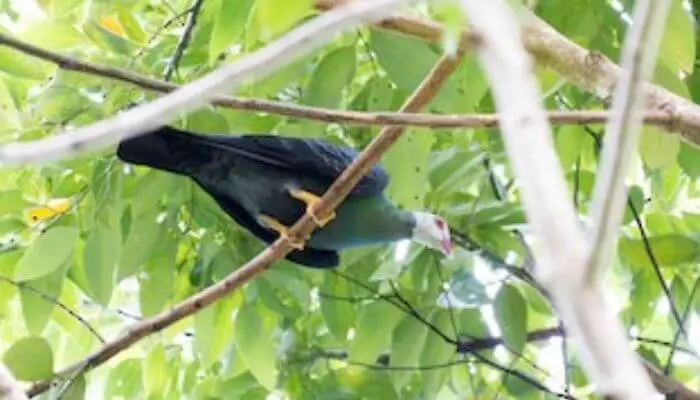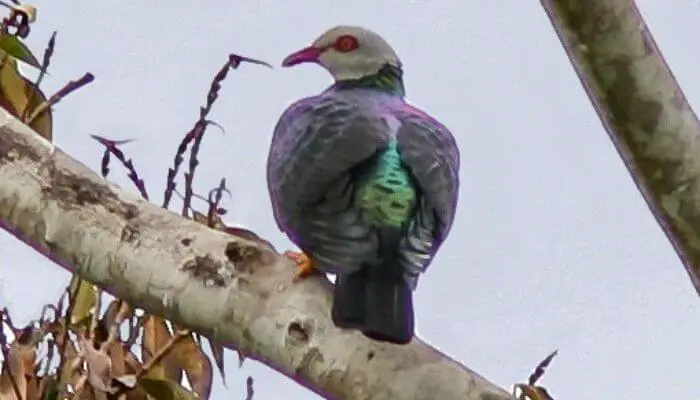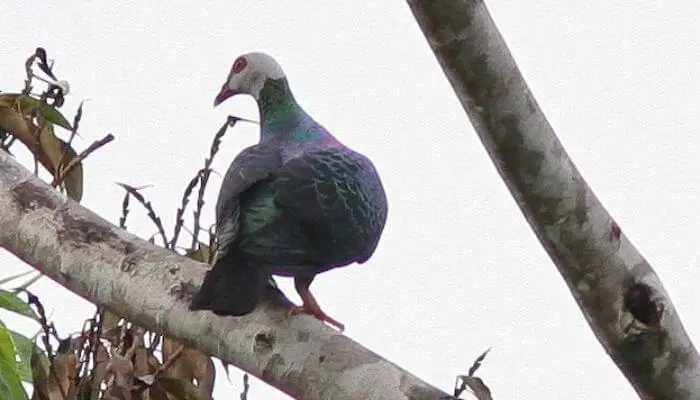The yellow-legged pigeon is a native bird of Papua New Guinea and several archipelagos in the South Pacific. It is named for its distinctive leg colouring.
It’s hard for the Columbidae family to compete in the interesting and beautiful stakes with the wonderful birds of paradise that inhabit the islands of the South Pacific, but the pigeons do their best to hold their own and there are some fascinating species. The yellow-legged pigeon is one of them.
Origins of the Yellow-Legged Pigeon
The Yellow-legged pigeon is a result of natural evolution.
It received its binomial name, Columba pallidecips, in 1877 from Edward Pierson Ramsay, an Australian zoologist who specialised in ornithology.
It is not to be confused with the yellow-footed green pigeon (also known as the yellow-legged green pigeon) which is a species native to the Indian Subcontinent.
Its closest relative is the metallic pigeon. Similar species are the white-throated pigeon, the New Britain bronzewing and the chestnut-bellied imperial pigeon.

Distribution And Habitat of the Yellow-Legged Pigeon
The yellow-legged pigeon is native to the island of New Guinea, the second largest island in the world.
New Guinea lies in the southwestern Pacific Ocean separated from Australia by the 150 miles of the Torres Strait.
The species is also found on nearby archipelagos including the Solomon Islands and Bismarck Islands.
Just some of the individual islands where it is found are Yapen, Biak, Bougainville, New Ireland, New Britain (all New Guinea), Choiseul, Vella Lavella, Tetepare, Nggela Islands, Guadalcanal, Ramos, Makira and Ugi (all Solomon Islands).
New Guinea and the surrounding islands have a diverse range of habitats including rainforests, montane forests and savannas.
The yellow-legged pigeon prefers the sub-canopy of well-forested areas. It is most abundant above 600 metres and up to 1300 metres but on some islands it likes lowland coastal forests above 400m.
Status of the Yellow-Legged Pigeon
Over the years, the yellow-legged pigeon has certainly been threatened by habitat loss. So much so, in fact, that it was formerly categorized as being Endangered by the IUCN.
More recent studies into the species found that the birds were not quite as rare as was once believed, and as a result, the yellow-legged pigeon was downlisted to the Vulnerable category in 2008.

Appearance of the Yellow-Legged Pigeon
| Wingspan | Length | Weight | Coloring | |
|---|---|---|---|---|
| Yellow-Legged Pigeon | 70 – 76 cm | 35 – 38 cm | 400 – 460 g | Dark brown/black, grey head and yellow legs |
| Average Feral Pigeon | 64 – 72 cm | 32 – 37 cm | 300 – 500 g | Bluish grey with some black |
The yellow-legged pigeon is a fairly large species.
It has two distinctive features – one being the long, rich yellow legs for which it is named.
The other is a pale silver/grey head with a pinkish, yellow-tipped bill, distinctive because it is in stark contrast to the body plumage.
The main body colour is a dark mix of brown, green and blue but there are iridescent feather tips which can be as varied as bright pink and pale green.
The underparts are a lighter brown in colour and the tail has a white band.
Yellow-Legged Pigeon Character
This species is not easily observed due to its fragmentation across numerous islands.
They are known to stay together in small flocks as they have been seen flying over forest canopies at dusk and dawn.
The yellow-legged pigeon is thought to be partially terrestrial and partially nomadic.
Another reason for not being able to closely examine this species is that it doesn’t have a wide range of vocalisations.
It is mostly a quiet bird but its voice is a typical pigeon-like low-pitched hooOO hooOO.

Diet of the Yellow-Legged Pigeon
The yellow-legged pigeon is a frugivorous species living on a diet of fruits and seeds.
It has been observed feeding on the ground as well as in trees.
A favourite roost and food source are tropical laurel trees that produce fig-like drupe fruits.
Yellow-Legged Pigeon Mating And Breeding
The breeding behaviours of the yellow-legged pigeon are not as well known as they could be but it is known they build simple platform nests that are made from twigs.
Nests have been recorded on the ground and in trees.
Once coupled, a yellow-legged pigeon pair will usually only lay one egg per clutch.
Care Of Yellow-Legged Pigeon
As the yellow-legged pigeon is a wild species that exists in only a certain area of the globe, the main care instructions that can really be given for it involve making a conscious effort to protect and maintain the natural habitats that the species thrives best in.
